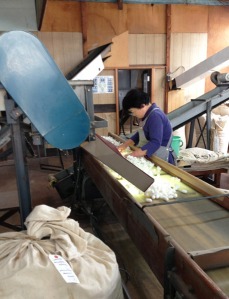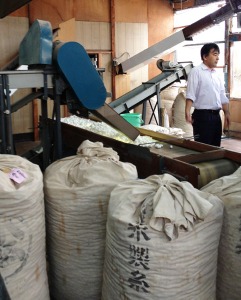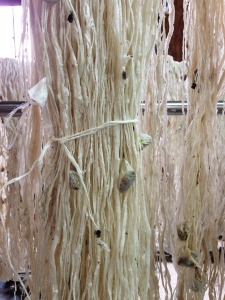From careful handwork to heavy machinery, there are many ways to unreel a silk cocoon.
Gunma Prefecture, north of Tokyo, is famous for silk production. In the 19th century Japan produced far more of the world’s silk than it does today (China has taken the title of world silk producer, much as it has taken over cotton production and many other textile industries), and all of that silk had to be unreeled somewhere. European-financed factories were built to provide European trade companies with the silk they desired, but over time these factories came to be owned by Japanese companies instead. Mountainous and beautiful, Gunma is still central to Japanese silk production as there are so few remaining silk producing factories left in Japan. These photos are from our visit to Usui Filature Mill in Gunma.
Cocoons are brought in, weighed, and evaluated. After setting a value on each sack, the cocoons are dried in large kilns where they will lose 60% of their weight. The sacks in the above photo weigh about 15 kilo.
The cocoons in the sacks below have already been dried and are ready for sorting and grading.
A worker stands at a conveyor belt that is lit from below. She carefully inspects each cocoon as it passes by, and removes any rejects.

I was told this yellow post-it note says “Best Quality”. The cocoons are smaller than most and the silk has a high luster. The cocoons in this batch may have come from the farmer we met in my last post! His reputation in the industry is outstanding, as he produces only the highest grade silk.
Below, waste silk not graded high enough for use in Japan is sent to Thailand. Note the dried pupae inside the thickly stretched fibers.
A single worker patrols each aisle of machines. There are several aisles of reeling machines in this factory, including some that were not being used. These machines were probably manufactured in the 1960s during Japan’s last silk boom, and no new reeling machines have been made for use in Japan since.
Each cocoon can produce around 1000 meters of filament; an impressive feat for something so small. Rotating brushes in a hot water bath catch filaments so the machine can unravel them.

Eight cocoons per reel bob in the water as bins pass by with more cocoons. As one cocoon reels out, another pops into its place from the bins. In the video below, you can see a little metal arm reach out to grab a cocoon from the bins as they pass by. Workers patrol the aisles between machines to make sure each reel is working as it should. Each worker wears a ring on her thumb that has a small cutting blade to break filaments when needed.
Silk Filature Mill, Japan from cziogas on Vimeo.
More from Usui in my next post, part 3.





One Comment Add yours